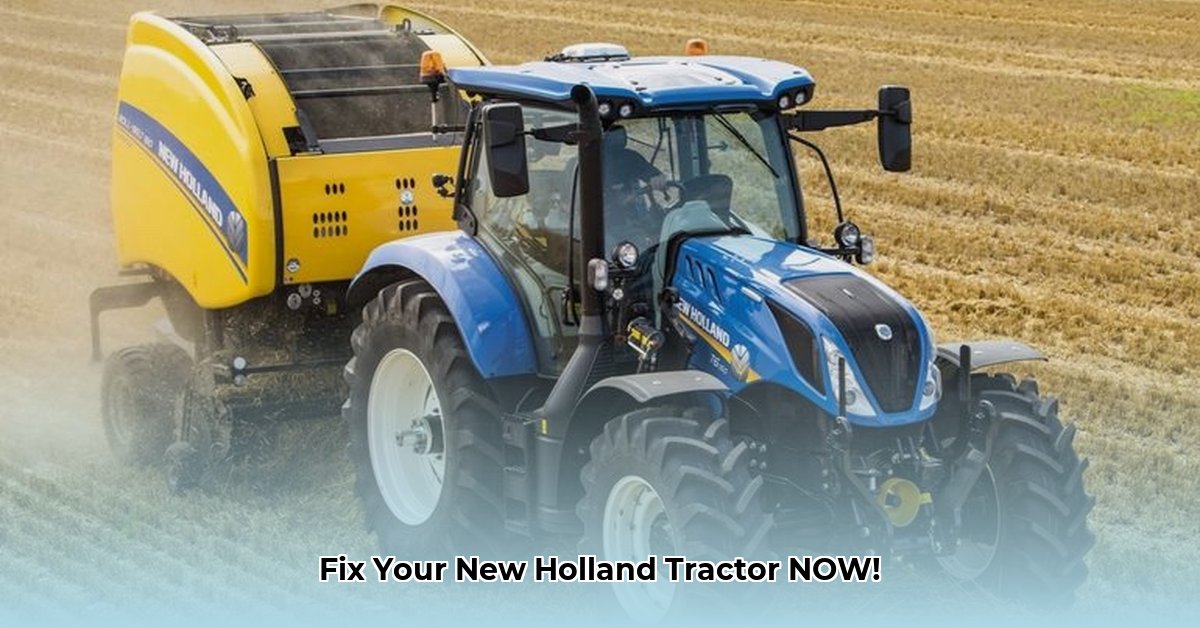
Dealing with a malfunctioning New Holland tractor can significantly impact productivity and profitability. This guide provides a step-by-step approach to troubleshooting common issues, empowering you to diagnose and resolve problems efficiently. We'll decode diagnostic trouble codes (DTCs), explore common fault areas, and emphasize safety throughout. For more specific New Holland tractor models, check out this helpful resource: New Holland Models.
Decoding Tractor Talk: Understanding Diagnostic Trouble Codes (DTCs)
New Holland tractors utilize alphanumeric Diagnostic Trouble Codes (DTCs) to signal mechanical problems. These codes, appearing on your tractor's onboard diagnostic system, provide crucial clues for diagnosis. While a single, publicly accessible database for all New Holland DTCs is unavailable, effective strategies exist for decoding them. Understanding DTCs is the first step in keeping your tractor running smoothly. What's your experience with deciphering tractor error messages?
Locating and Interpreting DTCs: A Step-by-Step Guide
Finding and interpreting DTCs is crucial for effective tractor maintenance. The process involves these steps:
- Locate the Diagnostic Port: Refer to your owner's manual to find the diagnostic port (usually a connector near the steering column).
- Connect Your Diagnostic Tool: Use a compatible diagnostic tool; options range from simple code readers to sophisticated software packages. The appropriate tool will depend on the tractor's system and your experience level.
- Retrieve the Codes: Follow the tool's instructions to retrieve stored DTCs. This might involve switching the ignition or briefly starting the engine. Record the codes accurately.
- Decode the Codes: Your owner's manual is the primary resource for deciphering codes. Each code specifically identifies a faulty part or system. If your manual is insufficient, consult a New Holland dealership for more comprehensive diagnostic resources.
Have you ever encountered an unfamiliar DTC on your New Holland tractor? What resources did you use to resolve the issue?
Common Problem Areas in New Holland Tractors
While DTCs provide precise information, identifying common fault areas speeds up troubleshooting. Here are frequent problem areas:
- Engine Issues: Engine DTCs often indicate problems with fuel delivery, ignition, faulty sensors, or general wear and tear. Symptoms might include reduced power, rough running, or unusual smoke.
- Transmission Problems: Transmission faults may result in difficulty shifting, slippage, or complete transmission failure. These issues typically require professional diagnosis and repair.
- Hydraulic System Malfunctions: Leaks, worn components, or low hydraulic fluid are common causes of hydraulic problems, ranging from minor inconveniences to substantial system failures.
- Electrical Anomalies: Faulty sensors, damaged wiring, or problems with the electrical control units (ECUs) can cause varied malfunctions, often requiring specialized tools and knowledge for diagnosis.
Case Study: Addressing a Fuel Injector Fault
Let's examine a fuel injector problem to illustrate a step-by-step troubleshooting approach:
- Safety First: Always disconnect the battery's negative terminal before working on electrical components. This critical safety precaution prevents electrical shocks.
- Visual Inspection: Begin with a visual inspection of the fuel injector. Check for visible damage, leaks, or corrosion. A simple visual check often reveals straightforward problems.
- Testing the Injector: Use specialized tools to test the injector's electrical connections, resistance, and spray pattern. These tests provide data-driven insights into the injector’s functionality.
- Replacement (if needed): If tests confirm a faulty injector, replace it following the manufacturer’s instructions precisely. Incorrect installation can cause further damage.
Approximately 90% of fuel injector problems can be solved through this methodical approach. What's your experience with fuel injector replacements?
Preventative Maintenance: A Proactive Approach
Proactive maintenance is crucial for preventing major breakdowns. Regular fluid changes, filter replacements, and visual inspections significantly reduce the risk of costly repairs. Following the recommended maintenance schedule in your owner's manual is essential for optimal tractor performance. Does your preventative maintenance schedule align with New Holland's recommendations?
Seeking Assistance: Resources and Support
Several resources can assist with more complex repairs:
- New Holland Dealership: New Holland dealerships offer expert diagnostics and repairs, possessing the necessary tools and specialized knowledge for complex problems.
- Online Communities: Engaging with online New Holland communities can provide valuable troubleshooting advice and insights from experienced users.
- Repair Manuals: Investing in a detailed repair manual for your tractor's model is a worthwhile investment. These manuals provide in-depth information and guides for addressing various issues.
This guide provides general information. Always consult your tractor's manual, and seek professional assistance when necessary. Remember, safety is paramount, and attempting repairs beyond your skill level can be dangerous. Always prioritize safety.